Modern chatbots can serve as digital agents, providing a new avenue for delivering 24/7 customer service and support across many industries. Their popularity stems from the ability to respond to customer inquiries in real time and handle multiple queries simultaneously in different languages. Chatbots also offer valuable data-driven insights into customer behavior while scaling effortlessly as the user base grows; therefore, they present a cost-effective solution for engaging customers. Chatbots use the advanced natural language capabilities of large language models (LLMs) to respond to customer questions. They can understand conversational language and respond naturally. However, chatbots that merely answer basic questions have limited utility. To become trusted advisors, chatbots need to provide thoughtful, tailored responses.
One way to enable more contextual conversations is by linking the chatbot to internal knowledge bases and information systems. Integrating proprietary enterprise data from internal knowledge bases enables chatbots to contextualize their responses to each user’s individual needs and interests. For example, a chatbot could suggest products that match a shopper’s preferences and past purchases, explain details in language adapted to the user’s level of expertise, or provide account support by accessing the customer’s specific records. The ability to intelligently incorporate information, understand natural language, and provide customized replies in a conversational flow allows chatbots to deliver real business value across diverse use cases.
The popular architecture pattern of Retrieval Augmented Generation (RAG) is often used to augment user query context and responses. RAG combines the capabilities of LLMs with the grounding in facts and real-world knowledge that comes from retrieving relevant texts and passages from corpus of data. These retrieved texts are then used to inform and ground the output, reducing hallucination and improving relevance.
In this post, we illustrate contextually enhancing a chatbot by using Knowledge Bases for Amazon Bedrock, a fully managed serverless service. The Knowledge Bases for Amazon Bedrock integration allows our chatbot to provide more relevant, personalized responses by linking user queries to related information data points. Internally, Amazon Bedrock uses embeddings stored in a vector database to augment user query context at runtime and enable a managed RAG architecture solution. We use the Amazon letters to shareholders dataset to develop this solution.
Retrieval Augmented Generation
RAG is an approach to natural language generation that incorporates information retrieval into the generation process. RAG architecture involves two key workflows: data preprocessing through ingestion, and text generation using enhanced context.
The data ingestion workflow uses LLMs to create embedding vectors that represent semantic meaning of texts. Embeddings are created for documents and user questions. The document embeddings are split into chunks and stored as indexes in a vector database. The text generation workflow then takes a question’s embedding vector and uses it to retrieve the most similar document chunks based on vector similarity. It augments prompts with these relevant chunks to generate an answer using the LLM. For more details, refer to the Primer on Retrieval Augmented Generation, Embeddings, and Vector Databases section in Preview – Connect Foundation Models to Your Company Data Sources with Agents for Amazon Bedrock.
The following diagram illustrates the high-level RAG architecture.
Although the RAG architecture has many advantages, it involves multiple components, including a database, retrieval mechanism, prompt, and generative model. Managing these interdependent parts can introduce complexities in system development and deployment. The integration of retrieval and generation also requires additional engineering effort and computational resources. Some open source libraries provide wrappers to reduce this overhead; however, changes to libraries can introduce errors and add additional overhead of versioning. Even with open source libraries, significant effort is required to write code, determine optimal chunk size, generate embeddings, and more. This setup work alone can take weeks depending on data volume.
Therefore, a managed solution that handles these undifferentiated tasks could streamline and accelerate the process of implementing and managing RAG applications.
Knowledge Bases for Amazon Bedrock
Knowledge Bases for Amazon Bedrock is a serverless option to build powerful conversational ai systems using RAG. It offers fully managed data ingestion and text generation workflows.
For data ingestion, it handles creating, storing, managing, and updating text embeddings of document data in the vector database automatically. It splits the documents into manageable chunks for efficient retrieval. The chunks are then converted to embeddings and written to a vector index, while allowing you to see the source documents when answering a question.
For text generation, Amazon Bedrock provides the RetrieveAndGenerate API to create embeddings of user queries, and retrieves relevant chunks from the vector database to generate accurate responses. It also supports source attribution and short-term memory needed for RAG applications.
This enables you to focus on your core business applications and removes the undifferentiated heavy lifting.
Solution overview
The solution presented in this post uses a chatbot created using a Streamlit application and includes the following AWS services:
The following diagram is a common solution architecture pattern you can use to integrate any chatbot application to Knowledge Bases for Amazon Bedrock.
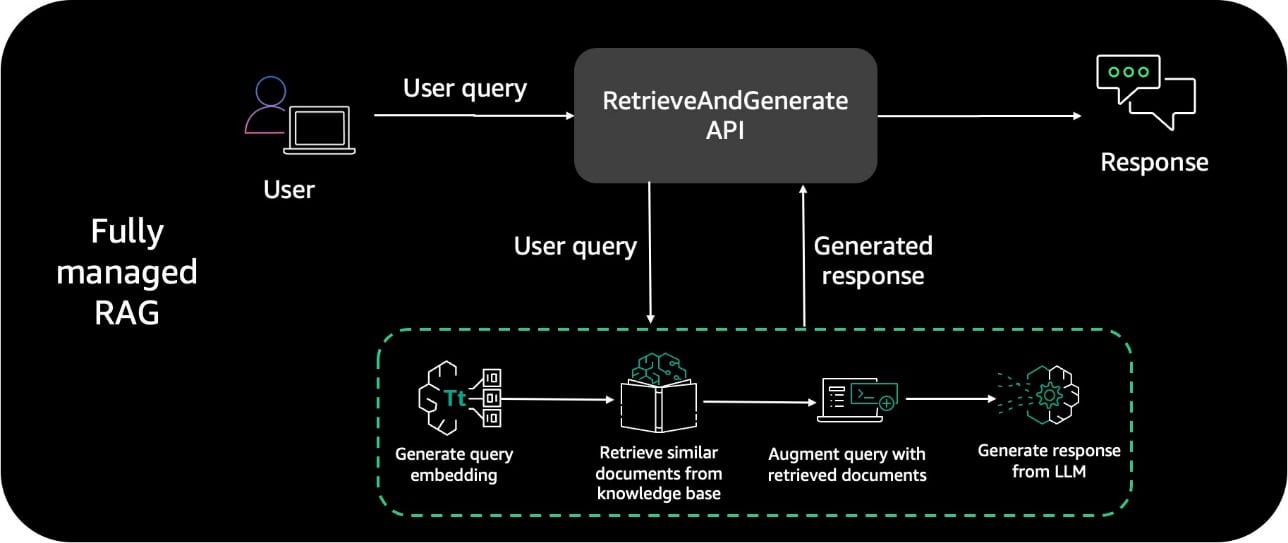
This architecture includes the following steps:
- A user interacts with the Streamlit chatbot interface and submits a query in natural language
- This triggers a Lambda function, which invokes the Knowledge Bases
RetrieveAndGenerateAPI. Internally, Knowledge Bases uses an Amazon Titan embedding model and converts the user query to a vector and finds chunks that are semantically similar to the user query. The user prompt is than augmented with the chunks that are retrieved from the knowledge base. The prompt alongside the additional context is then sent to a LLM for response generation. In this solution, we use Anthropic Claude Instant as our LLM to generate user responses using additional context. Note that this solution is supported in Regions where Anthropic Claude on Amazon Bedrock is available. - A contextually relevant response is sent back to the chatbot application and user.
Prerequisites
Amazon Bedrock users need to request access to foundation models before they are available for use. This is a one-time action and takes less than a minute. For this solution, you’ll need to enable access to the Titan Embeddings G1 – Text and Claude Instant – v1.2 model in Amazon Bedrock. For more information, refer to Model access.
Clone the GitHub repo
The solution presented in this post is available in the following GitHub repo. You need to clone the GitHub repository to your local machine. Open a terminal window and run the following command. Note this is one single git clone command.
Upload your knowledge dataset to Amazon S3
We download the dataset for our knowledge base and upload it into a S3 bucket. This dataset will feed and power knowledge base. Complete the following steps:
- Navigate to the Annual reports, proxies and shareholder letters data repository and download the last few years of Amazon shareholder letters.
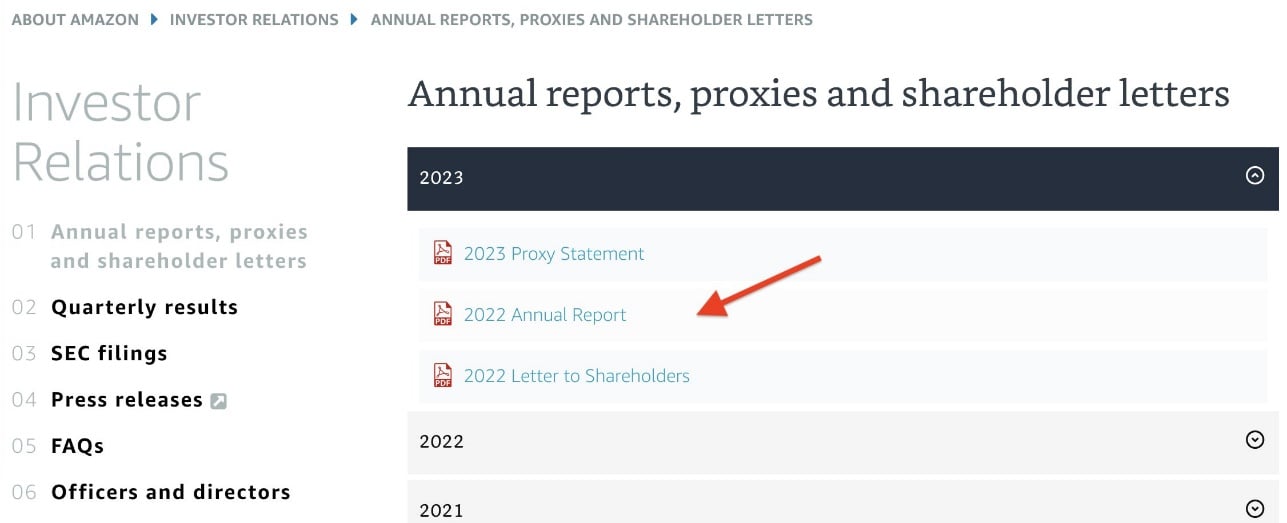
- On the Amazon S3 console, choose Buckets in the navigation pane.
- Choose Create bucket.
- Name the bucket
knowledgebase-<your-awsaccount-number>. - Leave all other bucket settings as default and choose Create.
- Navigate to the
knowledgebase-<your-awsaccount-number>bucket. - Choose Create folder and name it dataset.
- Leave all other folder settings as default and choose Create.
- Navigate back to the bucket home and choose Create folder to create a new folder and name it
lambdalayer. - Leave all other settings as default and choose Create.
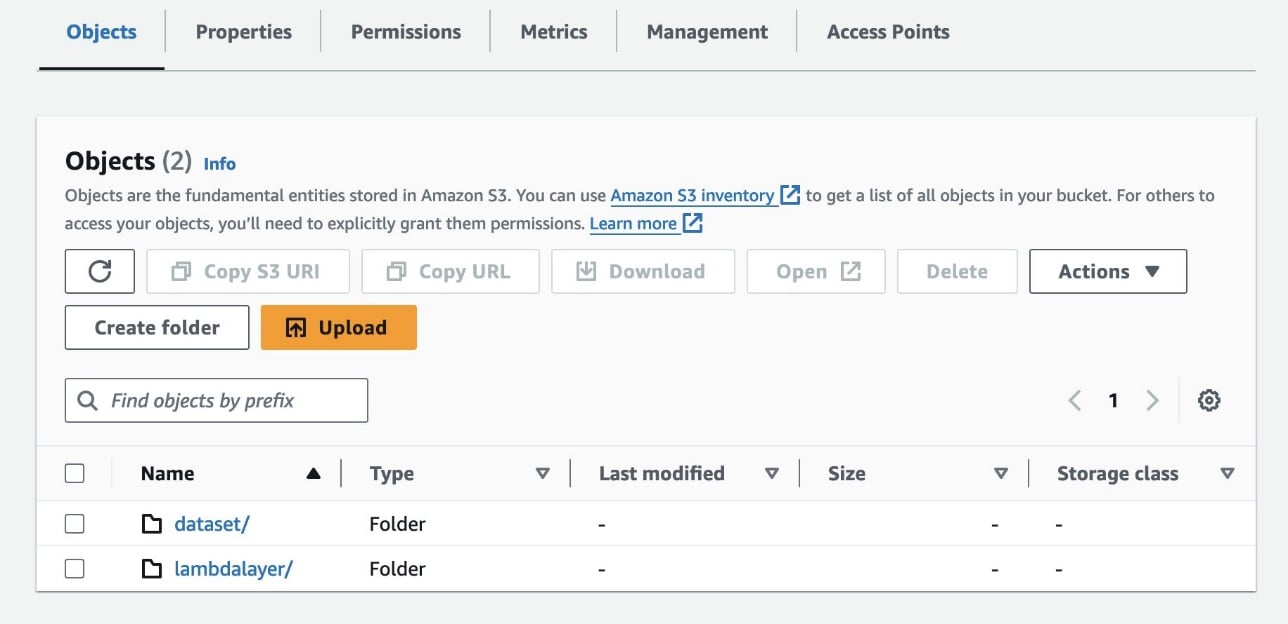
- Navigate to the
datasetfolder. - Upload the annual reports, proxies and shareholder letters dataset files you downloaded earlier to this bucket and choose Upload.
- Navigate to the
lambdalayerfolder. - Upload the
knowledgebase-lambdalayer.zipfile available under the/lambda/layerfolder in the GitHub repo you cloned earlier and choose Upload. You will use this Lambda layer code later to create the Lambda function.

Create a knowledge base
In this step, we create a knowledge base using the Amazon shareholder letters dataset we uploaded to our S3 bucket in the previous step.
- On the Amazon Bedrock console, under Orchestration in the navigation pane, choose Knowledge base.
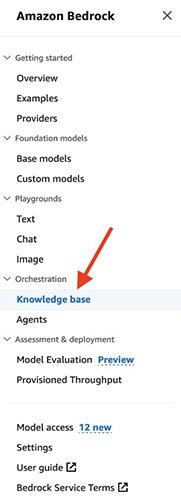
- Choose Create knowledge base.
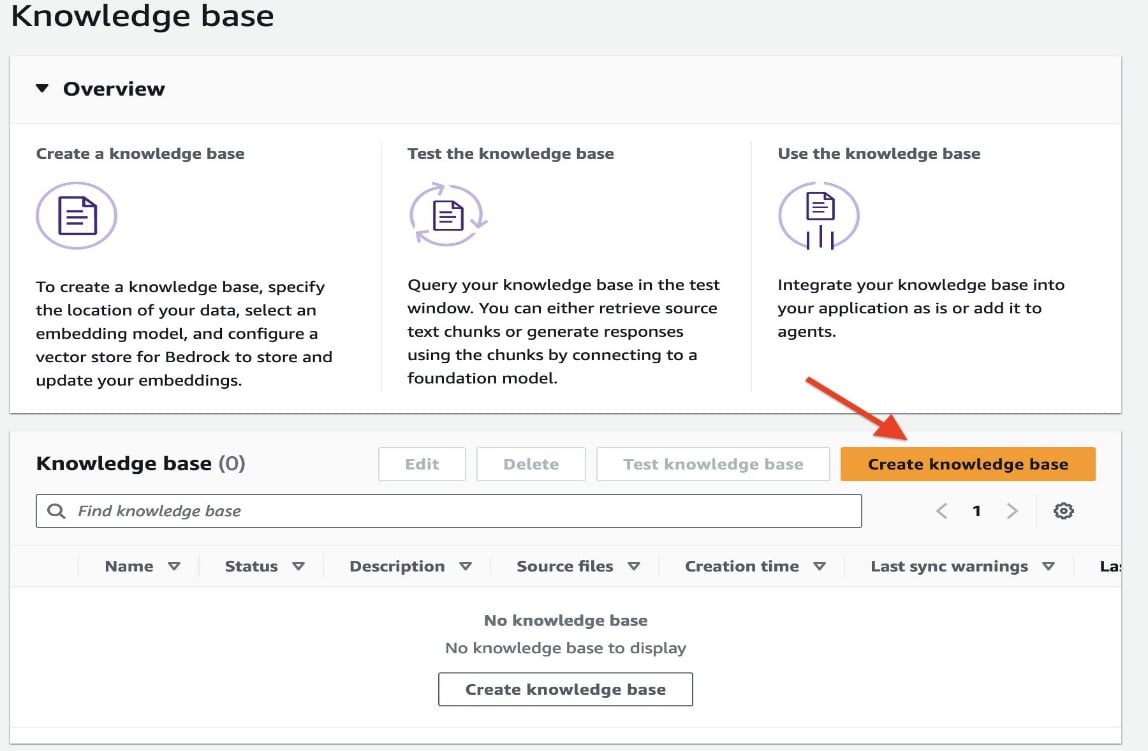
- In the Knowledge base details section, enter a name and optional description.
- In the IAM permissions section, select Create and use a new service role and enter a name for the role.
- Add tags as needed.
- Choose Next.
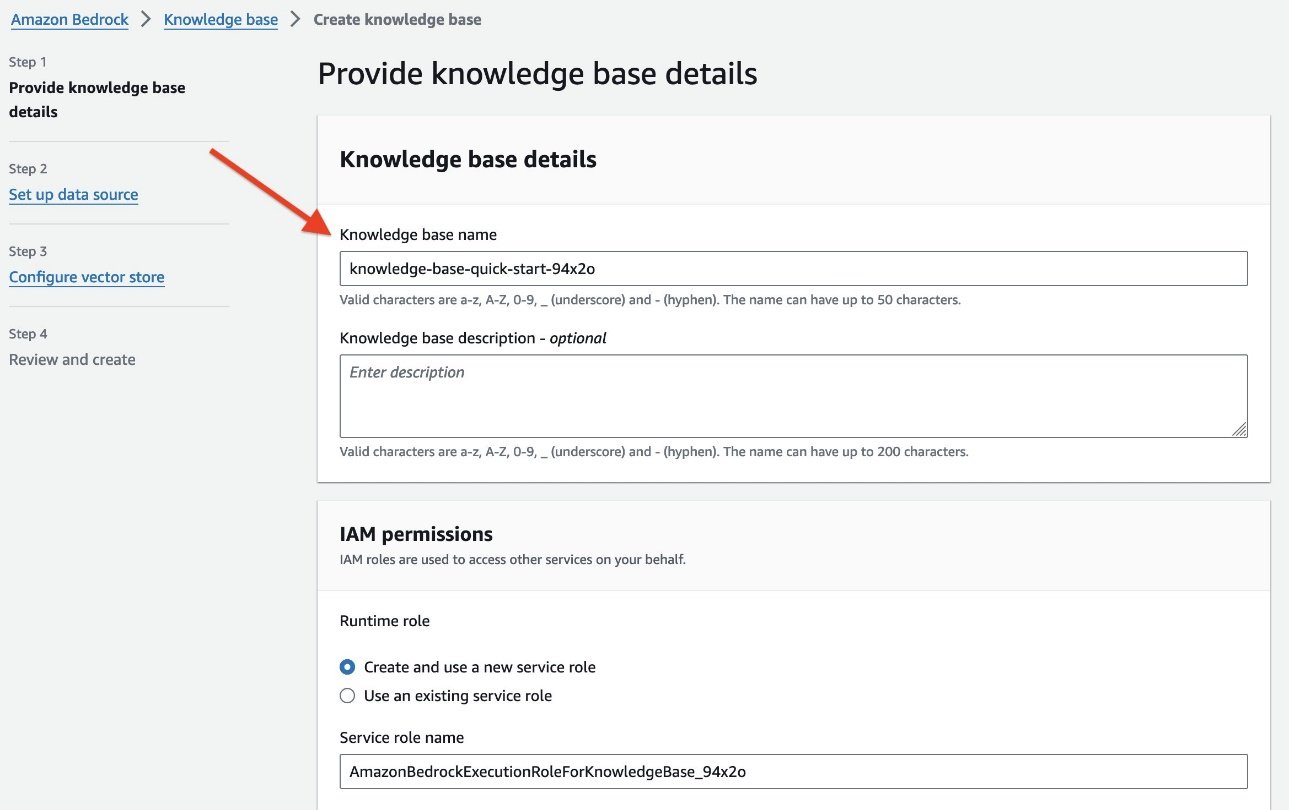
- Leave Data source name as the default name.
- For S3 URI, choose Browse S3 to choose the S3 bucket
knowledgebase-<your-account-number>/dataset/.You need to point to the bucket and dataset folder you created in the previous steps. - In the Advanced settings section, leave the default values (if you want, you can change the default chunking strategy and specify the chunk size and overlay in percentage).
- Choose Next.
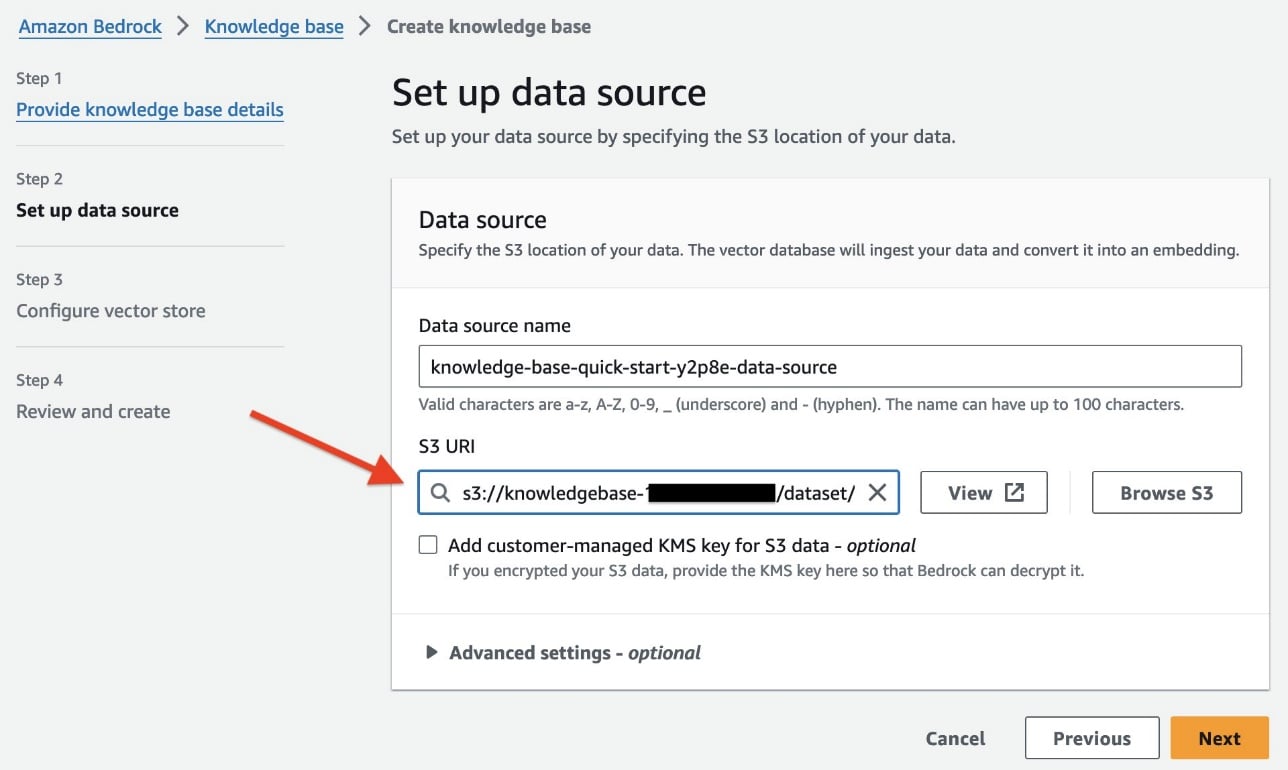
- For Embeddings model, select Titan Embedding G1 – Text.
- For Vector database, you can either select Quick create a new vector store or Choose a vector store you have created. Note that, to use the vector store of your choice, you need have a vector store preconfigured to use. We currently support four vector engine types: the vector engine for Amazon OpenSearch Serverless, Amazon Aurora, Pinecone, and Redis Enterprise Cloud. For this post, we select Quick create a new vector store, which by default creates a new OpenSearch Serverless vector store in your account.
- Choose Next.
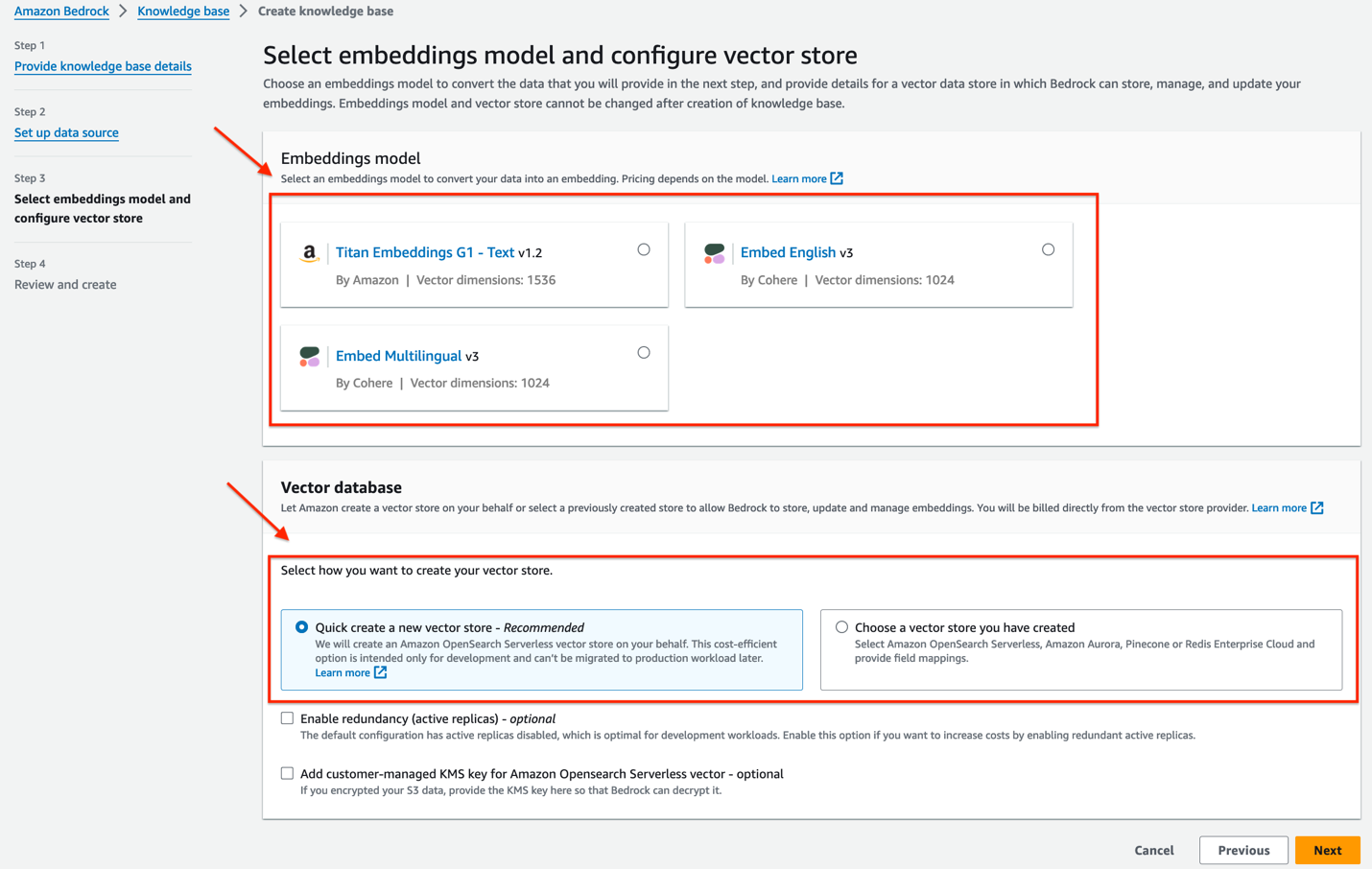
- On the Review and create page, review all the information, or choose Previous to modify any options.
- Choose Create knowledge base.
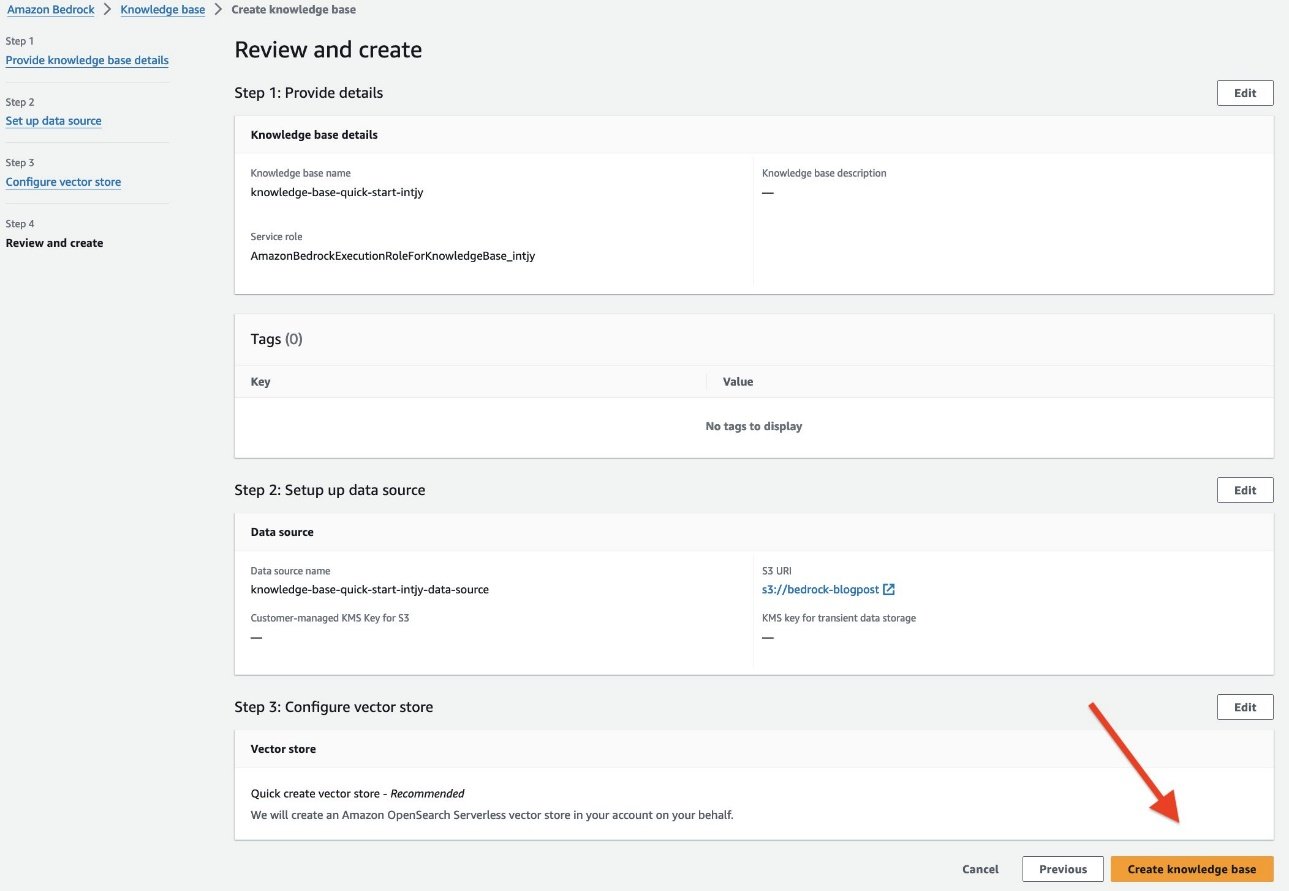 Note the knowledge base creation process begins and the status is In progress. It will take a few minutes to create the vector store and knowledge base. Don’t navigate away from the page, otherwise creation will fail.
Note the knowledge base creation process begins and the status is In progress. It will take a few minutes to create the vector store and knowledge base. Don’t navigate away from the page, otherwise creation will fail. - When the knowledge base status is in the
Readystate, note down the knowledge base ID. You will use it in the next steps to configure the Lambda function.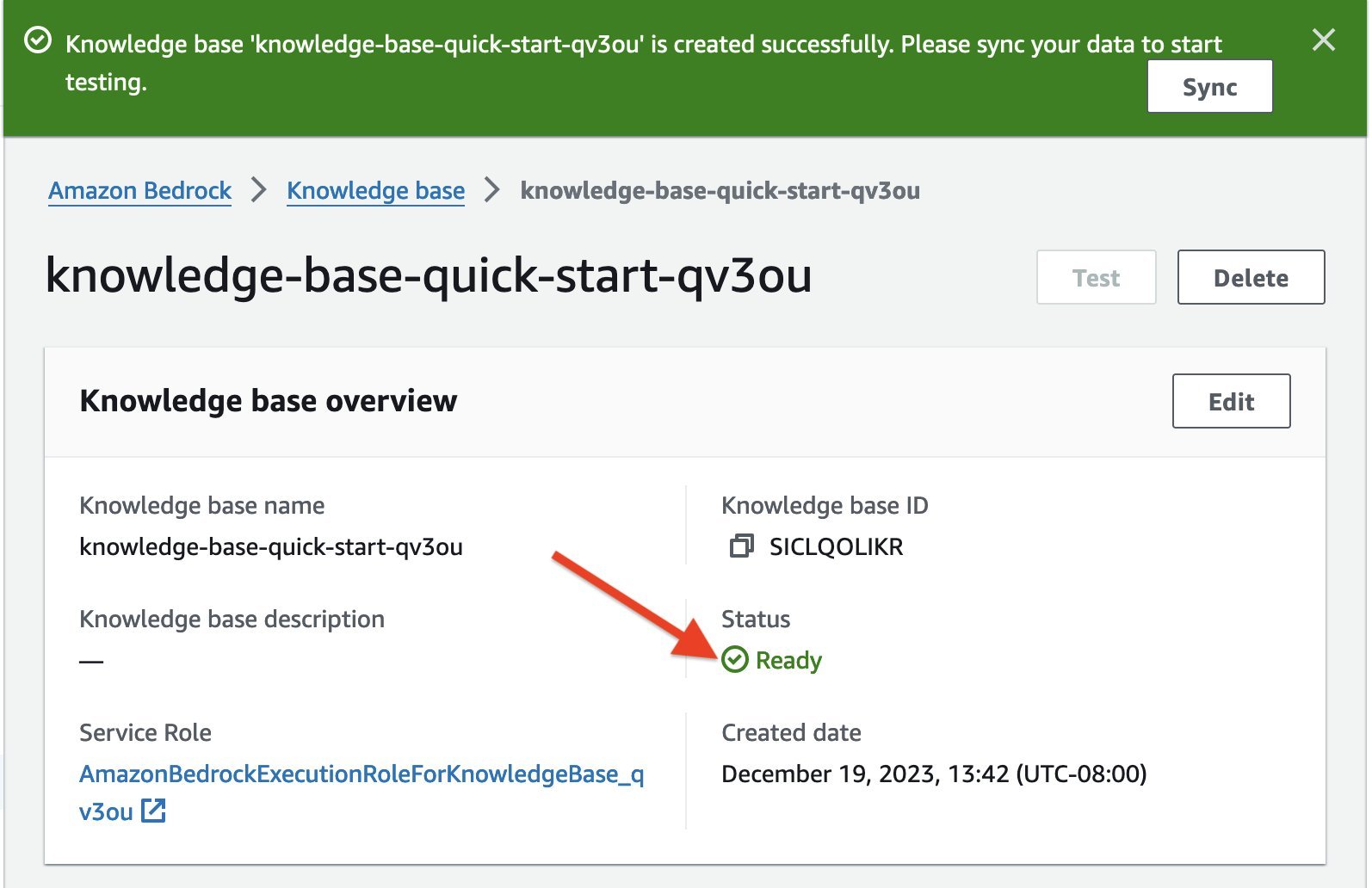
- Now that knowledge base is ready, we need to sync our Amazon shareholders letter data to it. In the Data Source section of the knowledge base details page, choose Sync to trigger the data ingestion process from the S3 bucket to the knowledge base.

This sync process splits the document files into smaller chunks of the chunk size specified earlier, generates vector embeddings using the selected text embedding model, and stores them in the vector store managed by Knowledge Bases for Amazon Bedrock.

When the dataset sync is complete, the status of the data source will change to the Ready state. Note that, if you add any additional documents in the S3 data folder, you need to re-sync the knowledge base.

Congratulations, your knowledge base is ready.
Note that you can also use Knowledge Bases for Amazon Bedrock service APIs and the AWS Command Line Interface (AWS CLI) to programmatically create a knowledge base. You will need to run various sections of the Jupyter notebook provided under the /notebook folder in the GitHub repo.
Create a Lambda function
This Lambda function is deployed using an AWS CloudFormation template available in the GitHub repo under the /cfn folder. The template requires two parameters: the S3 bucket name and the knowledge base ID.
- On the AWS CloudFormation service home page, choose Create stack to create a new stack.
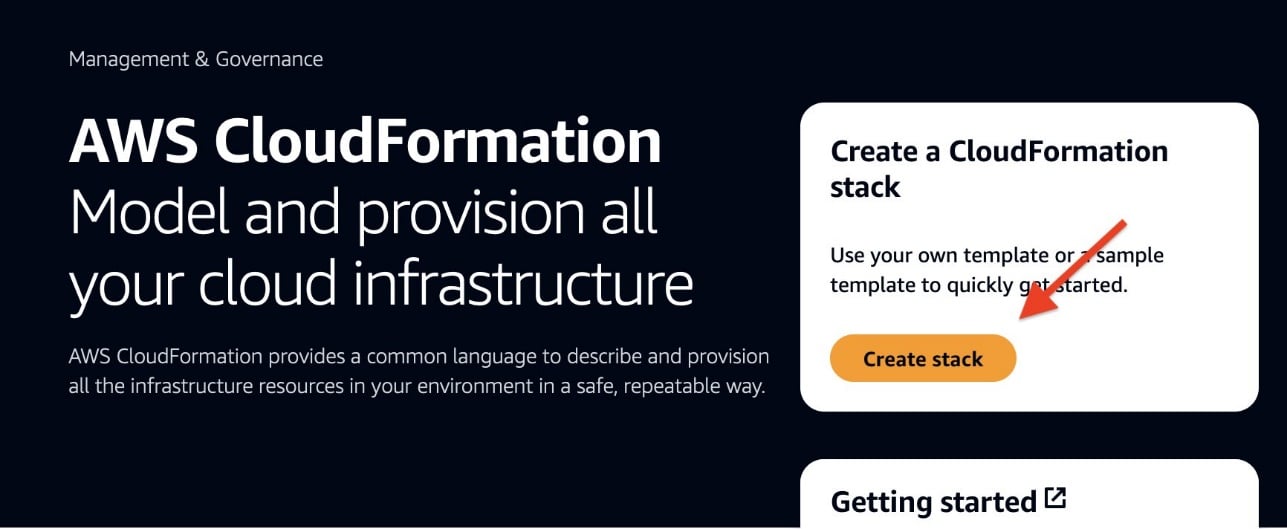
- Select Template is ready for Prepare template.
- Select Upload the template file for Template source.
- Choose Choose file, navigate to the GitHub repo you cloned earlier, and choose the .yaml file under the
/cfnfolder. - Choose Next.
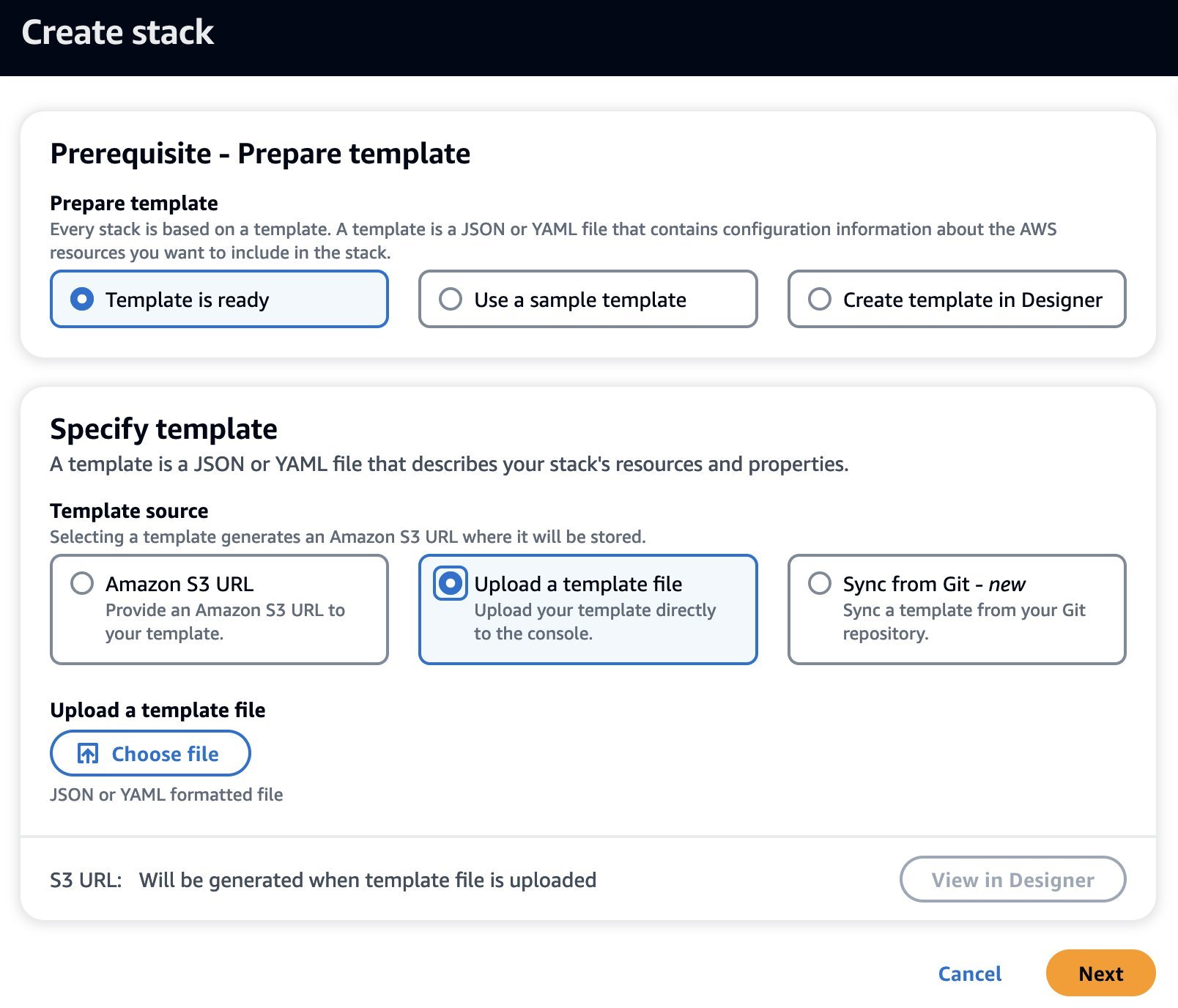
- For Stack name, enter a name.
- In the Parameters section, enter the knowledge base ID and S3 bucket name you noted down earlier.
- Choose Next.
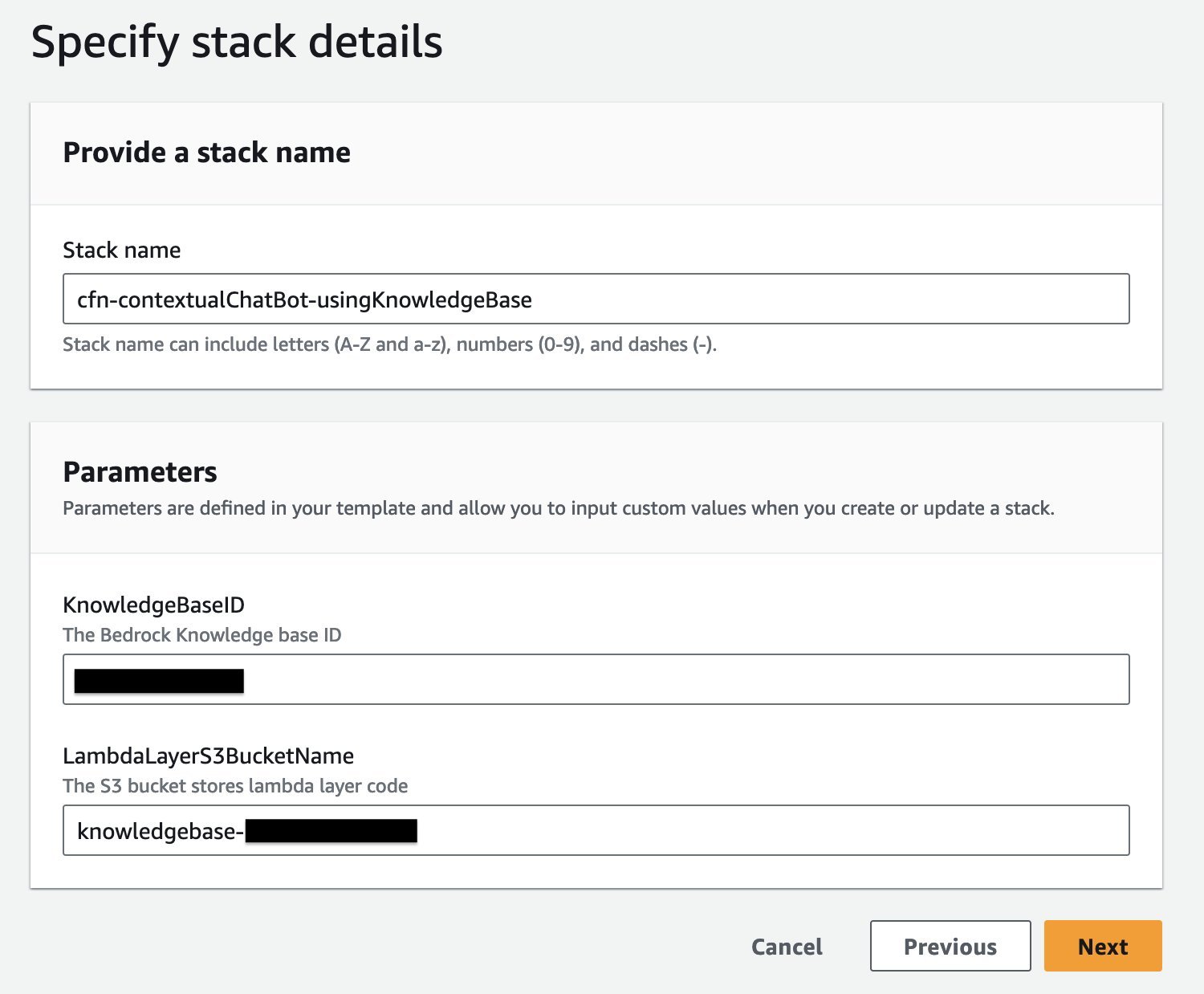
- Leave all default options as is, choose Next, and choose Submit.
- Verify that the CloudFormation template ran successfully, and there are no errors.
Congratulations, you have created a Lambda function, related roles, and policies successfully.
Test the contextual chatbot application
To test your chatbot application, complete the following steps:
- Open a new terminal or a command line window on your machine.
- Run the following command to install the AWS SDK for Python (Boto3). Boto3 makes it straightforward to integrate a Python application, library, or script with AWS services.
- Run the following command to install and set up a local Python development environment to run the Streamlit application:
- Navigate to the
/streamlitfolder in the GitHub repository folder you cloned earlier. - Run the following command to instantiate the chatbot application:
This should open a web-based chat application powered by Streamlit in your default web browser.
- Use this Streamlit chatbot application to post natural language questions to start the conversations powered by Knowledge Bases for Amazon Bedrock.

When you submit a prompt, the Streamlit app triggers the Lambda function, which invokes the Knowledge Bases RetrieveAndGenerate API to search and generate responses.
The following table includes some sample questions and related knowledge base responses. Try out some of these questions by using prompts.
| Questions | Answers |
| What is Amazon doing in the field of generative ai? | Amazon has been working on their own large language models (LLMs) for generative ai and believes it will transform and improve every customer experience. They plan to continue investing substantially in these models across all their consumer, seller, brand, and creator experiences. |
| What is AWS year-over-year revenue in 2022? | AWS revenue grew 29% year-over-year in 2022 on a $62 billion revenue base. |
| How many days has Amazon asked employees to come to work in office? | Amazon has asked corporate employees to come back to office at least three days a week beginning May 2022. |
| By what percentage did AWS revenue grow year-over-year in 2022? | AWS had a 29% year-over-year (‘YoY’) revenue in 2022. |
| Compared to Graviton2 processors, what performance improvement did Graviton3 chips deliver according to the passage? | In 2022, AWS delivered their Graviton3 chips, providing 25% better performance than the Graviton2 processors. |
| Which was the first inference chip launched by AWS according to the passage? | AWS launched their first inference chips (“Inferentia”) in 2019, and they have saved companies like Amazon over a hundred million dollars in capital expense. |
| According to the context, in what year did Amazon’s annual revenue increase from $245B to $434B? | Amazon’s annual revenue increased from $245B in 2019 to $434B in 2022. |
| Tell me again what was the revenue in 2019? | Amazon’s revenue in 2019 was $245 billion. |
| and, 2021? | Amazon’s revenue in 2021 was $469.8 billion, an increase of 22% over 2020. |
| And, remind me again when was the first inference chip was launched? | Amazon’s first inference chip was Inferentia, which launched in 2019. |
During the first call to the Lambda function, the RetrieveAndGenerate API returns a sessionId, which is then passed by the Streamlit app along with the subsequent user prompt as an input to the RetrieveAndGenerate API to continue the conversation in the same session. The RetrieveAndGenerate API manages the short-term memory and uses the chat history as long as the same sessionId is passed as an input in the successive calls.
Congratulations, you have successfully created and tested a chatbot application using Knowledge Bases for Amazon Bedrock.
Clean up
Failing to delete resources such as the S3 bucket, OpenSearch Serverless collection, and knowledge base will incur charges. To clean up these resources, delete the CloudFormation stack, delete the S3 bucket (including any document folders and files stored in that bucket), delete the OpenSearch Serverless collection, delete the knowledge base, and delete any roles, policies, and permissions that you created earlier.
Conclusion
In this post, we provided an overview of contextual chatbots and explained why they’re important. We described the complexities involved in data ingestion and text generation workflows for a RAG architecture. We then introduced how Knowledge Bases for Amazon Bedrock creates a fully managed serverless RAG system, including a vector store. Finally, we provided a solution architecture and sample code in a GitHub repo to retrieve and generate contextual responses for a chatbot application using a knowledge base.
By explaining the value of contextual chatbots, the challenges of RAG systems, and how Knowledge Bases for Amazon Bedrock addresses those challenges, this post aimed to showcase how Amazon Bedrock enables you to build sophisticated conversational ai applications with minimal effort.
For more information, see the Amazon Bedrock Developer Guide and Knowledge Base APIs.
About the Authors
 Manish Chugh is a Principal Solutions Architect at AWS based in San Francisco, CA. He specializes in machine learning and generative ai. He works with organizations ranging from large enterprises to early-stage startups on problems related to machine learning. His role involves helping these organizations architect scalable, secure, and cost-effective workloads on AWS. He regularly presents at AWS conferences and other partner events. Outside of work, he enjoys hiking on East Bay trails, road biking, and watching (and playing) cricket.
Manish Chugh is a Principal Solutions Architect at AWS based in San Francisco, CA. He specializes in machine learning and generative ai. He works with organizations ranging from large enterprises to early-stage startups on problems related to machine learning. His role involves helping these organizations architect scalable, secure, and cost-effective workloads on AWS. He regularly presents at AWS conferences and other partner events. Outside of work, he enjoys hiking on East Bay trails, road biking, and watching (and playing) cricket.
 Mani Khanuja is a tech Lead – Generative ai Specialists, author of the book Applied Machine Learning and High Performance Computing on AWS, and a member of the Board of Directors for Women in Manufacturing Education Foundation Board. She leads machine learning projects in various domains such as computer vision, natural language processing, and generative ai. She speaks at internal and external conferences such AWS re:Invent, Women in Manufacturing West, YouTube webinars, and GHC 23. In her free time, she likes to go for long runs along the beach.
Mani Khanuja is a tech Lead – Generative ai Specialists, author of the book Applied Machine Learning and High Performance Computing on AWS, and a member of the Board of Directors for Women in Manufacturing Education Foundation Board. She leads machine learning projects in various domains such as computer vision, natural language processing, and generative ai. She speaks at internal and external conferences such AWS re:Invent, Women in Manufacturing West, YouTube webinars, and GHC 23. In her free time, she likes to go for long runs along the beach.
 Pallavi Nargund is a Principal Solutions Architect at AWS. In her role as a cloud technology enabler, she works with customers to understand their goals and challenges, and give prescriptive guidance to achieve their objective with AWS offerings. She is passionate about women in technology and is a core member of Women in ai/ML at Amazon. She speaks at internal and external conferences such as AWS re:Invent, AWS Summits, and webinars. Outside of work she enjoys volunteering, gardening, cycling and hiking.
Pallavi Nargund is a Principal Solutions Architect at AWS. In her role as a cloud technology enabler, she works with customers to understand their goals and challenges, and give prescriptive guidance to achieve their objective with AWS offerings. She is passionate about women in technology and is a core member of Women in ai/ML at Amazon. She speaks at internal and external conferences such as AWS re:Invent, AWS Summits, and webinars. Outside of work she enjoys volunteering, gardening, cycling and hiking.
 NEWSLETTER
NEWSLETTER





